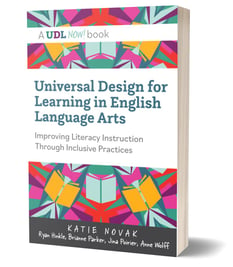In the face of a literacy crisis, educators and schools are looking to create a more equitable learning experience for all students. Recent news in Oregon highlights the complexity of the ongoing opportunity gap. Oregon’s State Board of Education's unanimous decision to extend the pause on the requirement for high school students to prove basic mastery of reading, writing, or math until at least 2029 underscores the debate on educational standards and equity. This decision reflects broader discussions on how to balance high academic standards with equitable access to opportunities for all students. I strongly believe that Universal Design for Learning (UDL) is part of the answer.
Despite popular opinion, UDL is more than “voice and choice” or using the UDL Guidelines as a checklist. UDL is grounded in the fundamental belief that all learners can succeed when we design the conditions students need to learn at high levels. When it comes to literacy, this means that we have to believe that every student can comprehend complex texts, actively contribute to rich classroom discussions, and produce authentic writing appropriate to the task, purpose, and audience. But how?
The 4 Core Components of Curriculum Through a UDL Lens
In our book, "Universal Design for Learning in English Language Arts," my fellow authors and I—four practicing English Language Arts (ELA) teachers—detail the application of UDL by identifying the four essential curriculum components that make up a comprehensive learning experience. These components are integral to any lesson planning approach, encompassing goals, methods, materials, and assessments. In UDL, when we talk about “firm goals, flexible means,” the methods, materials, and assessments are as flexible as possible while still providing opportunities for all learners to work toward the stated goal. The sections below delineate these core curriculum elements, each examined through the UDL perspective, and provide options and choices. It’s important to note that not all choices are created equal. It is critical that all pathways align with the firm goal and that students have opportunities to reflect and choose a pathway that creates a balance of challenge and support. One great strategy is to provide time for students to reflect on their options and then ask them to participate in a visible thinking strategy where they use words, pictures, or media to share what pathway they are choosing and why.
Goals
Every UDL-oriented lesson is grounded in a clear learning objective or firm goal articulated in state standards or district competencies. Using the standard's language without including terms that may restrict the goal is crucial.
- Instead of, “Students will write a five-paragraph argument essay,”
- Try this, “Students will write an argument,”
Why? This approach allows for a variety of outputs, such as essays, letters, and speeches, while staying true to the original language of the standard. When establishing your objectives, reflect on these questions:
- What does the standard require all learners to know or accomplish?
- Can the standard be interpreted in multiple ways? (For example, recognizing that there are various forms of written arguments)
Now, sometimes, there are standardized assessments that are not flexible. In UDL, always be clear about the purpose. For example, you may say, “In our upcoming state standardized test, you will be required to produce a multi-paragraph essay, so I want you to be prepared for that.” If you cannot offer flexibility in the goal, consider how you can offer flexible methods and materials outlined in the sections that follow.
Assessments
Assessments are tools for gathering information on a learner's performance. Diagnostic and formative assessments are tools you can use to refine instruction, so ensuring all assessment target standards will help you target instruction for students who have not mastered the standard yet. After unpacking the standard, consider creating a list of "acceptable evidence" that students can use to demonstrate they've met the goal or employ AI to generate such a list. This approach facilitates the development of a standards-based rubric capable of evaluating all potential options so you can create flexible groups based on performance on the rubric.
- Instead of, “Provide an accurate summary of the text, distinct from prior knowledge or opinions, in a well-written paragraph,”
- Try this, “Provide an accurate summary of the text, distinct from prior knowledge or opinion.” This revision opens the door for students to choose their mode of expression, whether it be writing a summary, recording an audio piece, producing a short video, or summarizing through multimedia or artistic formats. Regardless of output, the following rubric could be used to assess the summary.
Consider these questions when designing assessments:
- Does the unit offer opportunities for diagnostic, formative, and summative assessments that directly align with the firm goal?
- Are students provided with options on how to demonstrate their learning as they work toward firm goals, particularly in diagnostic and formative assessments?
Methods
There are a multitude of ways that students can build knowledge and skills. A universally designed lesson allows students to choose which methods they will use to learn.
- Instead of, handing out hard copies of a class text
- Try this: Provide options for students to comprehend the text based on the purpose of the reading. You may offer the option of a hard copy, a digital copy for translation or read-aloud, or the option to sit in a small group where one student is the reader.
When considering methods for delivery, consider:
- Do students have a choice about how they will build knowledge and access resources?
- What tools and strategies can you design so students reflect on their choices to determine if they were the most responsible choices for their learning?
Materials
When offering materials to your students, consider setting up a buffet of resources for students to choose from instead of requiring all students to use the same resources. Offer graphic organizers, checklists, rubrics, or exemplars. Because of variability, they won’t all need the same support, and they should be empowered to know themselves as learners and choose what they need.
- Instead of, requiring all students to complete a free-write to brainstorm, fill out a graphic organizer, and write a first draft by hand.
- Try this: Provide numerous options and choices for each stage of the writing process. Students can choose to brainstorm by having a discussion, completing a free-write, or sketching their ideas. To prepare to write, students could have a choice of creating an outline on paper or digitally or creating and completing a graphic organizer. When drafting, students may draft by hand or on a device. At each stage, students could have options to access checklists, rubrics, and exemplars.
When reflecting on the materials you are offering students, ask,
- Do students have a choice about the materials they will use to learn the lesson or complete the assessment?
Certainly, we don't want to prevent students from graduating because of an inaccessible test or lowered standards. However, by integrating Universal Design for Learning (UDL) principles, we can make instruction, standardized tests, and graduation requirements more inclusive, thus better preparing students for the future lives they aspire to lead. UDL offers a framework for creating educational environments that accommodate the varied ways in which individuals learn, thereby reducing barriers and maximizing learning for all students. This approach aligns with the need for equity in education, ensuring that all students, regardless of their backgrounds or learning differences, have access to the same opportunities for success.
 Ensure no student is left behind. Discover UDL Now! Universal Design for Learning for English Language Arts.
Ensure no student is left behind. Discover UDL Now! Universal Design for Learning for English Language Arts.



